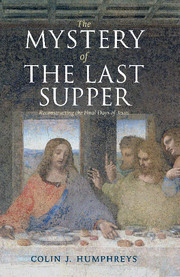48 results
From John Spence's Postdoc Time in Oxford to my Research on GaN and Graphene
-
- Journal:
- Microscopy and Microanalysis / Volume 28 / Issue S1 / August 2022
- Published online by Cambridge University Press:
- 22 July 2022, pp. 2736-2737
- Print publication:
- August 2022
-
- Article
-
- You have access
- Export citation
Interpersonal violence and mental health outcomes following disaster
-
- Journal:
- BJPsych Open / Volume 6 / Issue 1 / January 2020
- Published online by Cambridge University Press:
- 04 December 2019, e1
-
- Article
-
- You have access
- Open access
- HTML
- Export citation
Atomic Resolution Imaging of Dislocations in AlGaN and the Efficiency of UV LEDs
-
- Journal:
- Microscopy and Microanalysis / Volume 24 / Issue S1 / August 2018
- Published online by Cambridge University Press:
- 01 August 2018, pp. 4-5
- Print publication:
- August 2018
-
- Article
-
- You have access
- Export citation
How Cutting-Edge Atomic Resolution Microscopy Can Help to Solve Some of the World's Energy Problems
-
- Journal:
- Microscopy and Microanalysis / Volume 20 / Issue S3 / August 2014
- Published online by Cambridge University Press:
- 27 August 2014, pp. xcvii-c
- Print publication:
- August 2014
-
- Article
-
- You have access
- Export citation
How Cutting-Edge Atomic Resolution Microscopy Can Help to Solve Some of the World’s Energy Problems
-
- Journal:
- Microscopy and Microanalysis / Volume 20 / Issue S2 / August 2014
- Published online by Cambridge University Press:
- 29 July 2014, pp. 11-14
- Print publication:
- August 2014
-
- Article
- Export citation
Coincident Electron Channeling and Cathodoluminescence Studies of Threading Dislocations in GaN
-
- Journal:
- Microscopy and Microanalysis / Volume 20 / Issue 1 / February 2014
- Published online by Cambridge University Press:
- 12 November 2013, pp. 55-60
- Print publication:
- February 2014
-
- Article
- Export citation
35 - Lighting
- from Part 5 - Energy efficiency
-
-
- Book:
- Fundamentals of Materials for Energy and Environmental Sustainability
- Published online:
- 05 June 2012
- Print publication:
- 30 November 2011, pp 474-490
-
- Chapter
- Export citation
13 - A new reconstruction of the final days of Jesus
-
- Book:
- The Mystery of the Last Supper
- Published online:
- 03 May 2011
- Print publication:
- 28 March 2011, pp 191-196
-
- Chapter
- Export citation
1 - Four mysteries of the last week of Jesus
-
- Book:
- The Mystery of the Last Supper
- Published online:
- 03 May 2011
- Print publication:
- 28 March 2011, pp 1-13
-
- Chapter
- Export citation
Contents
-
- Book:
- The Mystery of the Last Supper
- Published online:
- 03 May 2011
- Print publication:
- 28 March 2011, pp v-v
-
- Chapter
- Export citation

The Mystery of the Last Supper
- Reconstructing the Final Days of Jesus
-
- Published online:
- 03 May 2011
- Print publication:
- 28 March 2011
7 - Did Jesus use the solar calendar of Qumran for his last supper Passover?
-
- Book:
- The Mystery of the Last Supper
- Published online:
- 03 May 2011
- Print publication:
- 28 March 2011, pp 95-109
-
- Chapter
- Export citation
9 - Discovering the lost calendar of ancient Israel
-
- Book:
- The Mystery of the Last Supper
- Published online:
- 03 May 2011
- Print publication:
- 28 March 2011, pp 121-134
-
- Chapter
- Export citation
11 - The date of the last supper: the hidden clues in the gospels
-
- Book:
- The Mystery of the Last Supper
- Published online:
- 03 May 2011
- Print publication:
- 28 March 2011, pp 151-168
-
- Chapter
- Export citation
2 - Dating the crucifixion – the first clues
-
- Book:
- The Mystery of the Last Supper
- Published online:
- 03 May 2011
- Print publication:
- 28 March 2011, pp 14-25
-
- Chapter
- Export citation
8 - Does ancient Egypt hold a key to unlocking the problem of the last supper?
-
- Book:
- The Mystery of the Last Supper
- Published online:
- 03 May 2011
- Print publication:
- 28 March 2011, pp 110-120
-
- Chapter
- Export citation
Bibliography
-
- Book:
- The Mystery of the Last Supper
- Published online:
- 03 May 2011
- Print publication:
- 28 March 2011, pp 227-233
-
- Chapter
- Export citation
12 - From the last supper to the crucifixion: a new analysis of the gospel accounts
-
- Book:
- The Mystery of the Last Supper
- Published online:
- 03 May 2011
- Print publication:
- 28 March 2011, pp 169-190
-
- Chapter
- Export citation
6 - The moon will be turned to blood
-
- Book:
- The Mystery of the Last Supper
- Published online:
- 03 May 2011
- Print publication:
- 28 March 2011, pp 80-94
-
- Chapter
- Export citation
Acknowledgements
-
- Book:
- The Mystery of the Last Supper
- Published online:
- 03 May 2011
- Print publication:
- 28 March 2011, pp xii-xiv
-
- Chapter
- Export citation



